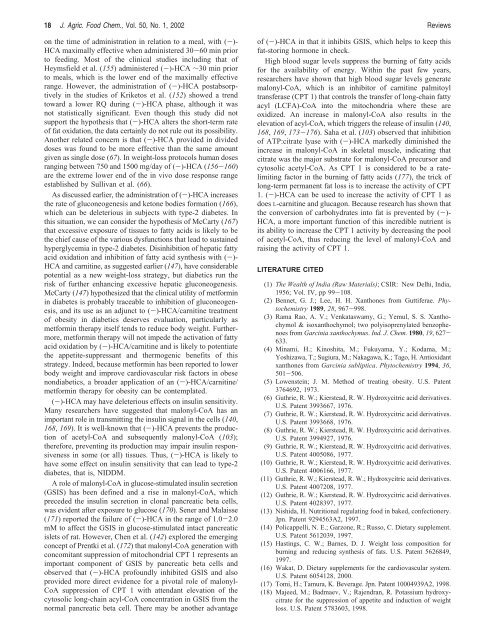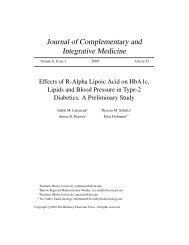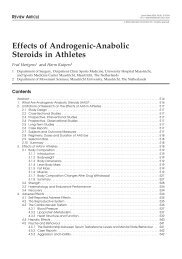Chemistry and Biochemistry of HCA.pdf - AFBoard.com
Chemistry and Biochemistry of HCA.pdf - AFBoard.com
Chemistry and Biochemistry of HCA.pdf - AFBoard.com
Create successful ePaper yourself
Turn your PDF publications into a flip-book with our unique Google optimized e-Paper software.
18 J. Agric. Food Chem., Vol. 50, No. 1, 2002 Reviews<br />
on the time <strong>of</strong> administration in relation to a meal, with (-)-<br />
<strong>HCA</strong> maximally effective when administered 30-60 min prior<br />
to feeding. Most <strong>of</strong> the clinical studies including that <strong>of</strong><br />
Heymsfield et al. (155) administered (-)-<strong>HCA</strong> ∼30 min prior<br />
to meals, which is the lower end <strong>of</strong> the maximally effective<br />
range. However, the administration <strong>of</strong> (-)-<strong>HCA</strong> postabsorptively<br />
in the studies <strong>of</strong> Kriketos et al. (152) showed a trend<br />
toward a lower RQ during (-)-<strong>HCA</strong> phase, although it was<br />
not statistically significant. Even though this study did not<br />
support the hypothesis that (-)-<strong>HCA</strong> alters the short-term rate<br />
<strong>of</strong> fat oxidation, the data certainly do not rule out its possibility.<br />
Another related concern is that (-)-<strong>HCA</strong> provided in divided<br />
doses was found to be more effective than the same amount<br />
given as single dose (67). In weight-loss protocols human doses<br />
ranging between 750 <strong>and</strong> 1500 mg/day <strong>of</strong> (-)-<strong>HCA</strong> (156-160)<br />
are the extreme lower end <strong>of</strong> the in vivo dose response range<br />
established by Sullivan et al. (66).<br />
As discussed earlier, the administration <strong>of</strong> (-)-<strong>HCA</strong> increases<br />
the rate <strong>of</strong> gluconeogenesis <strong>and</strong> ketone bodies formation (166),<br />
which can be deleterious in subjects with type-2 diabetes. In<br />
this situation, we can consider the hypothesis <strong>of</strong> McCarty (167)<br />
that excessive exposure <strong>of</strong> tissues to fatty acids is likely to be<br />
the chief cause <strong>of</strong> the various dysfunctions that lead to sustained<br />
hyperglycemia in type-2 diabetes. Disinhibition <strong>of</strong> hepatic fatty<br />
acid oxidation <strong>and</strong> inhibition <strong>of</strong> fatty acid synthesis with (-)-<br />
<strong>HCA</strong> <strong>and</strong> carnitine, as suggested earlier (147), have considerable<br />
potential as a new weight-loss strategy, but diabetics run the<br />
risk <strong>of</strong> further enhancing excessive hepatic gluconeogenesis.<br />
McCarty (147) hypothesized that the clinical utility <strong>of</strong> metformin<br />
in diabetes is probably traceable to inhibition <strong>of</strong> gluconeogenesis,<br />
<strong>and</strong> its use as an adjunct to (-)-<strong>HCA</strong>/carnitine treatment<br />
<strong>of</strong> obesity in diabetics deserves evaluation, particularly as<br />
metformin therapy itself tends to reduce body weight. Furthermore,<br />
metformin therapy will not impede the activation <strong>of</strong> fatty<br />
acid oxidation by (-)-<strong>HCA</strong>/carnitine <strong>and</strong> is likely to potentiate<br />
the appetite-suppressant <strong>and</strong> thermogenic benefits <strong>of</strong> this<br />
strategy. Indeed, because metformin has been reported to lower<br />
body weight <strong>and</strong> improve cardiovascular risk factors in obese<br />
nondiabetics, a broader application <strong>of</strong> an (-)-<strong>HCA</strong>/carnitine/<br />
metformin therapy for obesity can be contemplated.<br />
(-)-<strong>HCA</strong> may have deleterious effects on insulin sensitivity.<br />
Many researchers have suggested that malonyl-CoA has an<br />
important role in transmitting the insulin signal in the cells (140,<br />
168, 169). It is well-known that (-)-<strong>HCA</strong> prevents the production<br />
<strong>of</strong> acetyl-CoA <strong>and</strong> subsequently malonyl-CoA (103);<br />
therefore, preventing its production may impair insulin responsiveness<br />
in some (or all) tissues. Thus, (-)-<strong>HCA</strong> is likely to<br />
have some effect on insulin sensitivity that can lead to type-2<br />
diabetes, that is, NIDDM.<br />
A role <strong>of</strong> malonyl-CoA in glucose-stimulated insulin secretion<br />
(GSIS) has been defined <strong>and</strong> a rise in malonyl-CoA, which<br />
preceded the insulin secretion in clonal pancreatic beta cells,<br />
was evident after exposure to glucose (170). Sener <strong>and</strong> Malaisse<br />
(171) reported the failure <strong>of</strong> (-)-<strong>HCA</strong> in the range <strong>of</strong> 1.0-2.0<br />
mM to affect the GSIS in glucose-stimulated intact pancreatic<br />
islets <strong>of</strong> rat. However, Chen et al. (142) explored the emerging<br />
concept <strong>of</strong> Prentki et al. (172) that malonyl-CoA generation with<br />
con<strong>com</strong>itant suppression <strong>of</strong> mitochondrial CPT 1 represents an<br />
important <strong>com</strong>ponent <strong>of</strong> GSIS by pancreatic beta cells <strong>and</strong><br />
observed that (-)-<strong>HCA</strong> pr<strong>of</strong>oundly inhibited GSIS <strong>and</strong> also<br />
provided more direct evidence for a pivotal role <strong>of</strong> malonyl-<br />
CoA suppression <strong>of</strong> CPT 1 with attendant elevation <strong>of</strong> the<br />
cytosolic long-chain acyl-CoA concentration in GSIS from the<br />
normal pancreatic beta cell. There may be another advantage<br />
<strong>of</strong> (-)-<strong>HCA</strong> in that it inhibits GSIS, which helps to keep this<br />
fat-storing hormone in check.<br />
High blood sugar levels suppress the burning <strong>of</strong> fatty acids<br />
for the availability <strong>of</strong> energy. Within the past few years,<br />
researchers have shown that high blood sugar levels generate<br />
malonyl-CoA, which is an inhibitor <strong>of</strong> carnitine palmitoyl<br />
transferase (CPT 1) that controls the transfer <strong>of</strong> long-chain fatty<br />
acyl (LCFA)-CoA into the mitochondria where these are<br />
oxidized. An increase in malonyl-CoA also results in the<br />
elevation <strong>of</strong> acyl-CoA, which triggers the release <strong>of</strong> insulin (140,<br />
168, 169, 173-176). Saha et al. (103) observed that inhibition<br />
<strong>of</strong> ATP:citrate lyase with (-)-<strong>HCA</strong> markedly diminished the<br />
increase in malonyl-CoA in skeletal muscle, indicating that<br />
citrate was the major substrate for malonyl-CoA precursor <strong>and</strong><br />
cytosolic acetyl-CoA. As CPT 1 is considered to be a ratelimiting<br />
factor in the burning <strong>of</strong> fatty acids (177), the trick <strong>of</strong><br />
long-term permanent fat loss is to increase the activity <strong>of</strong> CPT<br />
1. (-)-<strong>HCA</strong> can be used to increase the activity <strong>of</strong> CPT 1 as<br />
does L-carnitine <strong>and</strong> glucagon. Because research has shown that<br />
the conversion <strong>of</strong> carbohydrates into fat is prevented by (-)-<br />
<strong>HCA</strong>, a more important function <strong>of</strong> this incredible nutrient is<br />
its ability to increase the CPT 1 activity by decreasing the pool<br />
<strong>of</strong> acetyl-CoA, thus reducing the level <strong>of</strong> malonyl-CoA <strong>and</strong><br />
raising the activity <strong>of</strong> CPT 1.<br />
LITERATURE CITED<br />
(1) The Wealth <strong>of</strong> India (Raw Materials); CSIR: New Delhi, India,<br />
1956; Vol. IV, pp 99-108.<br />
(2) Bennet, G. J.; Lee, H. H. Xanthones from Guttiferae. Phytochemistry<br />
1989, 28, 967-998.<br />
(3) Rama Rao, A. V.; Venkataswamy, G.; Yemul, S. S. Xanthochymol<br />
& isoxanthochymol; two polyisoprenylated benzophenoes<br />
from Garcinia xanthochymus. Ind. J. Chem. 1980, 19, 627-<br />
633.<br />
(4) Minami, H.; Kinoshita, M.; Fukuyama, Y.; Kodama, M.;<br />
Yoshizawa, T.; Sugiura, M.; Nakagawa, K.; Tago, H. Antioxidant<br />
xanthones from Garcinia subliptica. Phytochemistry 1994, 36,<br />
501-506.<br />
(5) Lowenstein; J. M. Method <strong>of</strong> treating obesity. U.S. Patent<br />
3764692, 1973.<br />
(6) Guthrie, R. W.; Kierstead, R. W. Hydroxycitric acid derivatives.<br />
U.S. Patent 3993667, 1976.<br />
(7) Guthrie, R. W.; Kierstead, R. W. Hydroxycitric acid derivatives.<br />
U.S. Patent 3993668, 1976.<br />
(8) Guthrie, R. W.; Kierstead, R. W. Hydroxycitric acid derivatives.<br />
U.S. Patent 3994927, 1976.<br />
(9) Guthrie, R. W.; Kierstead, R. W. Hydroxycitric acid derivatives.<br />
U.S. Patent 4005086, 1977.<br />
(10) Guthrie, R. W.; Kierstead, R. W. Hydroxycitric acid derivatives.<br />
U.S. Patent 4006166, 1977.<br />
(11) Guthrie, R. W.; Kierstead, R. W.; Hydroxycitric acid derivatives.<br />
U.S. Patent 4007208, 1977.<br />
(12) Guthrie, R. W.; Kierstead, R. W. Hydroxycitric acid derivatives.<br />
U.S. Patent 4028397, 1977.<br />
(13) Nishida, H. Nutritional regulating food in baked, confectionery.<br />
Jpn. Patent 9294563A2, 1997.<br />
(14) Policappelli, N. E.; Garzone, R.; Russo, C. Dietary supplement.<br />
U.S. Patent 5612039, 1997.<br />
(15) Hastings, C. W.; Barnes, D. J. Weight loss <strong>com</strong>position for<br />
burning <strong>and</strong> reducing synthesis <strong>of</strong> fats. U.S. Patent 5626849,<br />
1997.<br />
(16) Wakat, D. Dietary supplements for the cardiovascular system.<br />
U.S. Patent 6054128, 2000.<br />
(17) Tomi, H.; Tamura, K. Beverage. Jpn. Patent 10004939A2, 1998.<br />
(18) Majeed, M.; Badmaev, V.; Rajendran, R. Potassium hydroxycitrate<br />
for the suppression <strong>of</strong> appetite <strong>and</strong> induction <strong>of</strong> weight<br />
loss. U.S. Patent 5783603, 1998.




